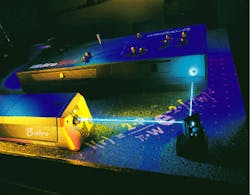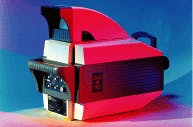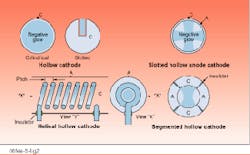Ion lasers are among the most venerable of laser technologies, with the first commercial models becoming available in the late 1960s. Using the transitions of ions in a heated plasma, such lasers suffer from low efficiencies and short lifetimes. Yet for a long time they dominated certain applications because they offered the only method for providing some wavelengths of light, especially short wavelengths into the ultraviolet (UV). In the present decade, ion lasers have faced direct competition from solid-state lasers. However, continuous refinements in ion-laser technology are extending their lifetimes, keeping them in the market, and even expanding their range of applications in some fields.
Ion-laser fundamentals
The lasing medium of ion lasers is a plasma—that is, an electrically conducting gas sufficiently hot that a significant fraction of all atoms have lost one or more electrons, becoming ions. In operation, an electrical discharge ionizes the gas and simultaneously pumps a fraction of the ions to an excited state. Lasing occurs when the excited ions are stimulated to emit photons in a transition to the ground state. As with other lasers, a resonant mirrored cavity provides for the creation of an amplified coherent and unidirectional beam.
Because ion lasers operate using atoms with at least one electron stripped away, they can involve transitions at higher energies than are generally possible in other lasers and thus at shorter wavelengths. Indeed, for a long time ion lasers were the only practical way to achieve UV laser emission. But they are inherently inefficient, because considerable energy must be expended in ionizing most or all of the atoms and in reionizing those that recombine with electrons, so only a small fraction goes into exciting the upper energy levels that contribute to lasing. In fact, most ion lasers have less than 0.1% efficiency. By comparison, for example, some diode lasers can have greater than 60% efficiency.
At the same time, ion lasers have long suffered from short lifetimes due to the high-energy environment in which they operate. Atoms can be eroded from the cathodes and they can be knocked off, or sputtered, from other structures by collision with energetic ions. Much current design work is aimed at lifetime extension.
On the positive side, ion lasers can reach very short wavelengths, below 300 nm, which are inaccessible to solid-state lasers, and they can provide high power levels and compact structures. Given their low efficiency, such high-power ion lasers are very power hungry, requiring 100-kW input power in some cases.
The simplest designs use noble gases, typically argon, krypton, or a mixture of both. Argon produces light in the range from green to blue wavelengths, with power outputs of up to 100 W. Krypton has a wider range, from red to blue wavelengths, but does not produce as high powers. An increasingly important class of ion lasers is based on combinations of helium or neon with metal vapors, such as copper, gold, silver, and cadmium. While some of these lasers operate in the visible, their biggest application is in UV production. Milliwatt continuous outputs have been achieved for HeAu at 282 nm, NeCu at 270 nm, and HeCu at 150 nm.
In experimental lasers, even shorter wavelengths, in the extreme UV, have been obtained for pulsed operation, with a group at Max Planck Institute for Quantum Optics (Garching, Germany) achieving lasing in laser-generated plasmas of scandium, calcium, and potassium at wavelengths from 35 to 53 nm. Such extreme UV radiation is of great interest in photolithography and bridges the gap between UV lasers and the more exotic x-ray lasers.
While krypton and argon have long been used for display due to their high power and variety of lasing frequencies, the main commercial applications of ion lasers generally take advantage of their UV capabilities as well as their high power. Digital disk mastering, photolithography, reprographics, and stereolithography are current leading applications. In disk mastering, the laser exposes photoresist on the disk, which can then be used to generate a photographic negative for disk production. The shorter the laser wavelength the smaller the disk size and the greater the amount of data stored. Similarly, in photolithography, the drive for thinner lines and more circuits requires manufacturers to go ever deeper into the UV.
In stereolithography, used in rapid prototyping, a computer-controlled laser photocures the top layer of a polymer in a polymer bath. New layers are added as the bath surface is lowered, producing a three-dimensional model. The costly and time-consuming process of manual model-making from blueprints is thus avoided, but high power and short wavelengths are needed to cure the polymers quickly.
Ion-laser design
An ion laser consists of a cathode and anode to pass the current through the plasma, the fill gas that is to be ionized, and an optical cavity. In a typical design, the cathode is a helical tungsten coil, the anode a flat copper disk (see Fig. 1). In between the cathode and anode, an optical cavity is maintained by apertures in tungsten disks spaced along the length of the laser tube. These are, in turn, supported by copper disks with suitable holes to allow for gas recirculation. The ends of the tube have standard fully and partially reflective mirrors with a quartz exit window. The tube is contained by a ceramic envelope that passes heat to a water-cooling system.In extending ion-laser lifetimes from the hundreds of hours characteristic of the early 1980s to the 5000-10,000 hours available today, particular attention has had to be devoted to erosion problems. The tungsten bore is an especially weak point. Recirculation design has to aim at producing a very even distribution of pressure along the bore, because sputtering rates increase with lower pressure, producing localized failures. Much the same considerations apply to cathode erosion, which appears to halt entirely if the gas pressure near the cathode is maintained above a certain value.
Recent research has indicated that considerable improvements in laser gain and output can be obtained by changing the geometry of the cathode and anode. Instead of locating the cathode at one end and the anode at the other, or placing the cathode inside the anode, a Monash University (Clayton, Australia) group has shown better results with a segmented cathode design, in which the anode and cathode are alternate segments of a common cylinder, separated by insulating material (see Fig. 2). The electrodes not only provide the current but are also the source of the metal ions in these helium-metal ion lasers.The advantage of the segmented cathode design is that it increases the voltage of operation, resulting in more-energetic electrons and thus a greater production of excited ions. Gain can be increased by as much as fourfold, leading to more efficient operation.
At this time, ion lasers, despite their low efficiency, seem relatively protected in their low-wavelength niche. But solid-state lasers continue to nip at their heels.
Until very recently, wavelengths around 200 nm could only be achieved by frequency-quadrupling solid-state laser outputs in the infrared, because frequency-doubling would require initial wavelengths around 400 nm, in the blue-wavelength range. Such frequency-quadrupling sapped the efficiency of the solid-state systems and added greatly to their cost and complexity. Now, however, blue-emitting lasers are beginning to reach commercialization, which means that 200 nm could be achieved merely with frequency-doubling. The designers of ion lasers are going to have to continue pushing to higher efficiency and shorter wavelengths to maintain their grip on this section of the laser market.
FURTHER READING
Roderick Tobin et al., "High Gain Hollow Cathode Metal Ion Lasers for the UV and VUV," IEEE J. Selected Topics in Quantum Electronics 1, 805 (Sept. 1993).
P. T. Ginouves, Laser Focus World 32(3), 69 (March 1996).
About the Author
Eric J. Lerner
Contributing Editor, Laser Focus World
Eric J. Lerner is a contributing editor for Laser Focus World.


